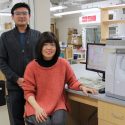National stem cell bank announces addition of new cell lines
The National Stem Cell Bank has expanded its offering of human embryonic stem cell lines to include cells from the University of California, San Francisco (UCSF), it announced today (Sept. 19). With the addition of the UCSF lines, the National Stem Cell Bank will soon have on deposit 13 of the 21 cell lines on the federal registry.
The National Institutes of Health (NIH) established the country’s first — and, so far, only — national stem cell bank at the WiCell Research Institute in Madison late last year. Its mission is to obtain, characterize and distribute the 21 human embryonic stem cell lines on the NIH Stem Cell Registry, which have been approved for federally funded research.
“The addition of the UCSF stem cell lines broadens the diversity of human embryonic stem cell lines available for research and enables us to conduct comparative studies on the lines to share with scientists around the world who are working with the cells,” says Beth Donley, executive director of the WiCell Research Institute.
WiCell scientists are characterizing the cells in the National Stem Cell Bank to support the development of human embryonic stem cells for research and therapeutic applications. Their work includes trying to understand how each cell line behaves under different conditions in the laboratory; testing the cells for animal disease; and assessing their potential to become specific tissues, such as heart cells or pancreatic islet cells.
Owners of NIH-registry stem cell lines around the world have been invited to deposit their cells in the National Stem Cell Bank. Derek Hei, a WiCell researcher and leader of the National Stem Cell Bank, says the diversity of available human embryonic stem cell lines is a critical issue from the standpoint of increasing scientists’ basic scientific understanding of embryonic stem cells and their potential use in clinical applications.
“The added diversity that the UCSF cell lines bring to the program will help to increase the value of the information that is obtained from future characterization studies,” Hei says. “We look forward to collaborating with UCSF and other cell line providers as they deposit their cells for inclusion in National Stem Cell Bank distribution and characterization activities.”
In conjunction with the characterization studies for the National Stem Cell Bank, WiCell also provides hands-on training in the handling and care of human embryonic stem cells and expert technical support to the stem cell research community.
Since its establishment in September 2005, the National Stem Cell Bank has created a commerce-enabled Web site, through which scientists from nonprofit and academic institutions anywhere in the world can request stem cell lines. The site provides protocols, information on specific lines, and technical support for stem cell researchers around the world. The site also offers resources for the public, including teachers and members of the media, to learn about stem cells.
The WiCell Research Institute is dedicated to expanding the frontiers of science and medicine by unlocking the potential of stem cells. As a subsidiary of the Wisconsin Alumni Research Foundation and a supporting organization of the University of Wisconsin–Madison, WiCell conducts research, supports research at UW–Madison, hosts the National Stem Cell Bank, provides training for scientists and offers educational outreach programs for K-12 students and the community.
Tags: biosciences, research, stem cells



